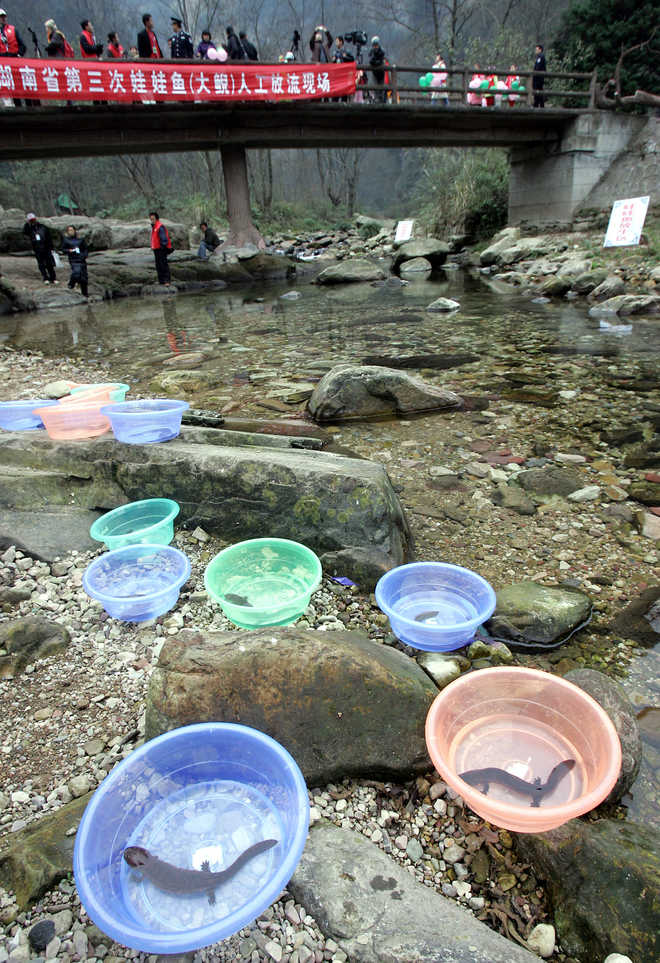
In this file photo taken on December 10, 2005, bowls containing baby Chinese giant salamanders, which can grow up to 1.8 meters (6 feet) in length, the largest in the world, prior to a ceremony to release them back into a stream during the China International Conservation festival in Zhangjiajie, central China''s Hunan province. AFP file
Beijing
The Chinese giant salamander—well known as the world's largest amphibian—may in fact be at least five separate species, each facing imminent threat of extinction in the wild, a study has found.
Researchers from Chinese Academy of Sciences in eijing highlight the importance of genetic assessments to properly identify the salamanders.
The study suggests that the farming and release of giant salamanders back into the wild without any regard for their genetic differences is putting the salamanders' already dire future at even greater risk.
In fact, some of the five newly identified species may already be extinct in the wild.
With individuals weighing in at more than 140 pounds, Chinese giant salamanders were so far thought to be critically endangered.
The study published in the journal Current Biology shows that those giant salamanders are not one species, but five, and possibly as many as eight.
Another report in the same journal found that all of the salamanders face the imminent threat of extinction in the wild, due in no small part to demand for the amphibians as luxury food.
"We were not surprised to discover more than one species, as an earlier study suggested, but the extent of diversity—perhaps up to eight specie— uncovered by the analyses sat us back in our chairs," said Jing Che from the Chinese Academy of Sciences.
"The overexploitation of these incredible animals for human consumption has had a catastrophic effect on their numbers in the wild over an amazingly short time span," said Samuel Turvey, from Zoological Society of London in the UK.
"Unless coordinated conservation measures are put in place as a matter of urgency, the future of the world's largest amphibian is in serious jeopardy," Turvey said.
The researchers were surprised to learn just how much movement of salamanders has already occurred due to human intervention.
Salamander farms have sought to "maximise variation" by exchanging salamanders from distant areas, without realising they are in fact distinct species, Che said.
As a result, wild populations may now be at risk of becoming locally maladapted due to hybridisation across species boundaries.
The researchers suspected Chinese giant salamanders might represent distinct species despite their similar appearances. That is because the salamanders inhabit three primary rivers in China, and several smaller ones, they explain. Each runs independently to sea.
Given that giant salamanders cannot move across the land, they suspected that salamanders living in different river systems might have had opportunity to diverge over time into what should now be recognised as distinct species.
In the second study, researchers conducted field surveys and interviews from 2013 and 2016, in an effort that was possibly the largest wildlife survey ever conducted in China.
The data revealed that populations of this once-widespread species are now critically depleted or extirpated across all surveyed areas of their range, and illegal poaching is widespread. The researchers were unable to confirm survival of wild salamanders at any survey site.
While the harvesting of wild salamanders is already prohibited, the findings show that farming practices and existing conservation activities that treat all salamander populations as a single species are potentially doing great damage, researchers said. PTI



























